You’re working in a global company that launches a new product and start receiving thousands of customer queries in just a few hours. Human agents alone can’t keep up, so the business turns to AI chatbots for instant, automated support.
Yes, this is exactly where platforms like Botpress come in, which offers tools to build intelligent conversational assistants. But as companies grow and their needs become more complex, questions arise; how much does Botpress cost across different regions, what limitations might businesses face, and which Botpress alternatives could provide better enterprise solutions?
In this review, we’ll explore everything you need to know about Botpress in 2025, including its global pricing, key drawbacks, and the best alternatives available for enterprises today.
What Is Botpress AI? 2025 Core Features, Pros & Cons (Global Enterprise Focus)

Botpress AI is an open-source conversational AI platform that helps businesses design, deploy, and manage intelligent chatbots across multiple channels. Unlike traditional chatbot builders that rely only on rule-based flows, Botpress combines advanced AI capabilities with developer-level customization. This makes it popular among enterprises that want full control over their data, scalability, and integrations.
In 2025, Botpress AI has become more than just a chatbot creator; it serves as a framework for building AI-driven agents that can connect to knowledge bases, integrate with enterprise tools, and operate securely across on-premises, private cloud, or hybrid environments.
Main Core Features (2025 Update)
Botpress AI continues to evolve, and its latest updates bring a mix of advanced automation and enterprise-ready features:
- AI-Powered Flow Builder – A visual drag-and-drop tool that allows teams to design conversation paths while using AI to handle intent recognition, slot-filling, and fallback responses.
- Multichannel Deployment – Businesses can launch bots across web apps, WhatsApp, Messenger, Slack, and custom applications, ensuring consistent user experience worldwide.
- Enterprise-Grade NLU & NLP – With multilingual support and retrieval-augmented generation (RAG), Botpress can handle complex customer interactions and domain-specific queries more effectively.
- Plugin & Integration Ecosystem – A growing marketplace and SDK let developers build or install plugins for platforms like Salesforce, Zendesk, Zapier, and other enterprise systems.
- Self-Hosting & Data Control – Unlike many SaaS chatbot tools, Botpress AI allows organizations to deploy bots on-premises or in their private cloud, providing more control over sensitive customer data.
- Conversational Analytics – Businesses gain insights into user queries, intent accuracy, conversation drop-offs, and performance metrics for continuous improvement.
- Knowledge Base Integration – Enterprises can connect bots directly to documentation, FAQs, or company databases, enabling AI agents to answer domain-specific questions instantly.
Pros of Botpress AI
Enterprises often choose Botpress because it offers flexibility and strong control over AI-driven interactions. Some of its biggest strengths include:
- Open-source engine and SDK support allow enterprises to extend functionality as needed.
- Ability to deploy on private cloud or on-premises helps companies meet strict compliance standards.
- Advanced NLU, multilingual capabilities, and integration with RAG workflows provide highly intelligent chatbot performance.
- Suitable for businesses operating across multiple countries and channels, ensuring consistent global deployment.
- Ready-to-use connectors for CRMs, support tools, and APIs make Botpress AI adaptable to different workflows.
- Built-in reports help teams understand performance and improve chatbot experiences over time.
Cons of Botpress AI
While Botpress AI is powerful, it is not without its drawbacks. Businesses should consider these limitations before adoption:
- The platform is highly flexible, but non-technical users may struggle with the advanced flow builder and developer-oriented features.
- Unlike some no-code chatbot platforms, Botpress requires developer involvement, making it less suitable for small businesses that need quick setup.
- Enterprise-level security, compliance, and dedicated support come at a higher cost, which may not be affordable for smaller teams.
- While excellent for support and automation, it lacks advanced marketing automation for social channels like Facebook or Instagram.
- Since it can be self-hosted, enterprises must allocate IT resources for deployment and ongoing management.
How Much Does Botpress Cost in 2025? Global Pricing Tiers & Hidden Fees
When businesses evaluate chatbot platforms, one of the first questions that comes up is: “How much does it really cost?” Botpress pricing 2025 follows a tiered model with a mix of free, self-serve, and enterprise subscription options. On the surface, the pricing looks simple, but when you add in usage-based costs, third-party channel fees, and AI token consumption, the total bill can become complex and sometimes unpredictable. This is why many companies not only review Botpress pricing carefully but also compare it with Botpress alternatives to avoid hidden expenses.

The Core Pricing Tiers in 2025
Botpress currently offers four main plans: Pay-as-you-go, Plus, Team, and Enterprise.
- Pay-as-you-go (Free/Usage-Based): Designed for solo developers or hobbyists, this plan starts at $0 per month and gives access to the visual builder, community support, and a small monthly AI credit. However, any real usage—such as extra bots, storage, or AI calls; quickly adds incremental costs. This makes it ideal for testing, but not for long-term production use.
- Plus Plan: Priced at $89/month (or $79 if billed annually), this tier is for small teams launching production bots. It includes live-agent handoff, visual knowledge base indexing, and live chat support. While the base fee looks affordable, costs still rise due to per-message fees and AI usage, which are billed separately.
- Team Plan: Aimed at growing businesses, this plan costs $495/month (or $445 with annual billing). It adds collaboration features like real-time editing, role-based access control, and priority support. However, even at this level, AI usage and channel fees remain additional, which can push costs much higher for companies with large customer bases.
- Enterprise Plan: Large organizations usually require custom contracts that start around $2,000/month on multi-year agreements. This includes advanced security, onboarding support, SLAs, and data residency controls. Still, AI token usage and third-party channel costs (like WhatsApp or SMS) are billed separately, meaning the headline subscription fee is only part of the total expense.
Usage-Based Costs and AI Spend
One of the biggest factors in Botpress pricing 2025 is AI consumption. Businesses can either:
- Use Botpress-managed AI credits, where token costs are added to the Botpress bill.
- Bring their own LLM key (e.g., from OpenAI or Anthropic), where AI token costs are billed directly by the model provider.
While the second option can reduce double-billing and leverage enterprise discounts, many teams still face challenges forecasting token usage. Long or complex conversations can quickly multiply costs, especially when bots rely on multiple AI calls for each query.
Third-Party Channel Fees
Another area that often surprises companies is channel-based pricing. If you connect WhatsApp, SMS, or voice services, those charges are not included in your Botpress subscription. Instead, they are billed separately by providers like Meta (for WhatsApp) or Twilio (for SMS/voice). In some cases, these external fees can exceed the cost of Botpress itself, especially during large campaigns or seasonal spikes in customer activity.
Hidden Fees and Renewal Surprises
Several enterprises have reported “renewal shocks” when their usage patterns changed. For example, teams may start with a mid-tier plan but, after running campaigns with higher traffic, find that normalized overages, extra editor seats, and larger channel bills raise their renewal costs far beyond initial expectations. Because Botpress bills overages automatically, without hard stops, companies must set usage alerts and track AI consumption closely to avoid unplanned expenses.
Is Botpress Worth the Cost?
For startups and small teams, the free or Plus plan can provide a good starting point. However, as organizations scale, Botpress pricing becomes less predictable because of usage-based billing and separate channel fees. Enterprises that prioritize data control, security, and customization may still find the investment worthwhile, but they should be ready for careful cost monitoring.
At the same time, businesses looking for fixed-cost, no-code solutions often compare Botpress pricing 2025 with Botpress alternatives that offer more transparent billing. Alternatives may provide unlimited usage or bundled AI credits, which can reduce financial risk for organizations with high or unpredictable traffic.
In short, while Botpress AI delivers strong enterprise features, its pricing model in 2025 is complex and often variable. Companies planning global deployments should forecast message volumes, AI token usage, and channel mix carefully, or evaluate Botpress alternatives that offer simpler and more predictable pricing.
Top 8 Botpress Alternatives in 2025 (Global Enterprise Rankings)
When businesses outgrow the limitations of Botpress AI, the next step is often to look for enterprise-grade solutions that offer stronger customization, compliance, and scalability. While Botpress alternatives have become more diverse in recent years, only a few platforms are built to handle the real-world challenges of global enterprises, such as strict data regulations, proprietary knowledge integration, and high-volume multi-channel support.
1. GPTBots: End-to-End Enterprise AI Agent Platform

GPTBots is more than just a chatbot/Agent builder; it’s a full-stack enterprise AI platform tailored to companies that need secure, scalable, and deeply customized AI agents. What sets GPTBots apart from other Botpress alternatives is its ability to train bots directly on proprietary enterprise data, ensuring that responses aren’t generic but highly aligned with a company’s unique knowledge base, products, and compliance requirements.
While Botpress AI gives businesses a decent start, it often leaves growing organizations struggling with hidden costs, fragmented channel fees, and limited enterprise-level support. GPTBots solves these challenges by combining flexibility with enterprise security, offering organizations a predictable and future-proof AI deployment strategy.
What makes it the Best Botpress Alternative?
1. Trained on Proprietary Enterprise Data
GPTBots allows organizations to feed the platform with internal documents, PDFs, spreadsheets, and even entire knowledge bases. This ensures the chatbot or AI agent speaks in the company’s own voice, understands domain-specific processes, and delivers accurate, context-rich responses. For industries like healthcare, finance, or legal; where accuracy and compliance matter, this is a major step up from the more generic AI workflows seen in Botpress AI.

2. Global Compliance & Enterprise Security
Unlike many tools that take a “one-size-fits-all” cloud approach, GPTBots provides flexible deployment models, including on-premise and private cloud hosting. This ensures businesses remain fully compliant with regional and global regulations like GDPR, HIPAA, or SOC 2. Role-based access control and audit logging further guarantee that sensitive enterprise data remains protected at every level.
3. Expert Solution Provider for Enterprises
One of the biggest gaps enterprises face with tools like Botpress is the lack of hands-on expert support. GPTBots addresses this by offering direct guidance from AI specialists—helping with onboarding, customization, optimization, and scaling. For enterprise teams that don’t want to experiment endlessly with settings and add-ons, this expert-led approach ensures faster ROI and a smoother AI adoption journey.
4. Omni-Channel and Multi-Modal Capabilities
GPTBots goes beyond simple text-based support. It can process multimedia inputs like images, voice, and video; making it especially useful for industries like healthcare (scanning reports), retail (visual product queries), and travel (multimedia recommendations). It also integrates seamlessly with channels like WhatsApp, Slack, Messenger, Discord, CRMs, and internal IT systems, ensuring enterprises can reach users wherever they are.
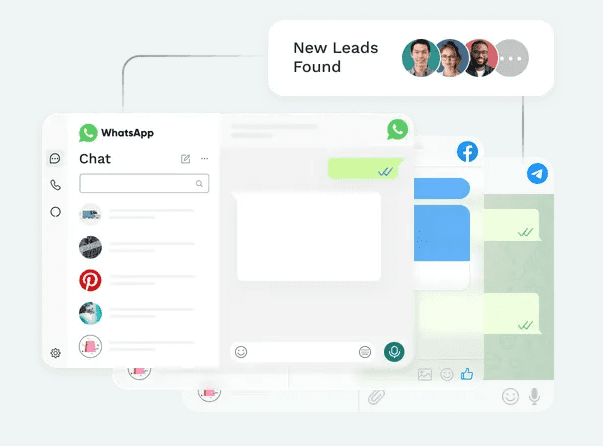
Pros of GPTBots
- Purpose-built for enterprises with global compliance and data security at the core
- Ability to train bots on proprietary data for domain-specific accuracy
- Flexible deployment (cloud, private cloud, or on-premise)
- Supports text, image, audio, and video inputs for advanced use cases
- Seamless integrations with enterprise tools, CRMs, and communication platforms
- Expert-led guidance and hands-on enterprise support
- Scales smoothly without unpredictable overage fees common in Botpress AI
Cons of GPTBots
- In our testing and review, we haven’t found any significant flaws or disadvantages at this stage
2. Tidio
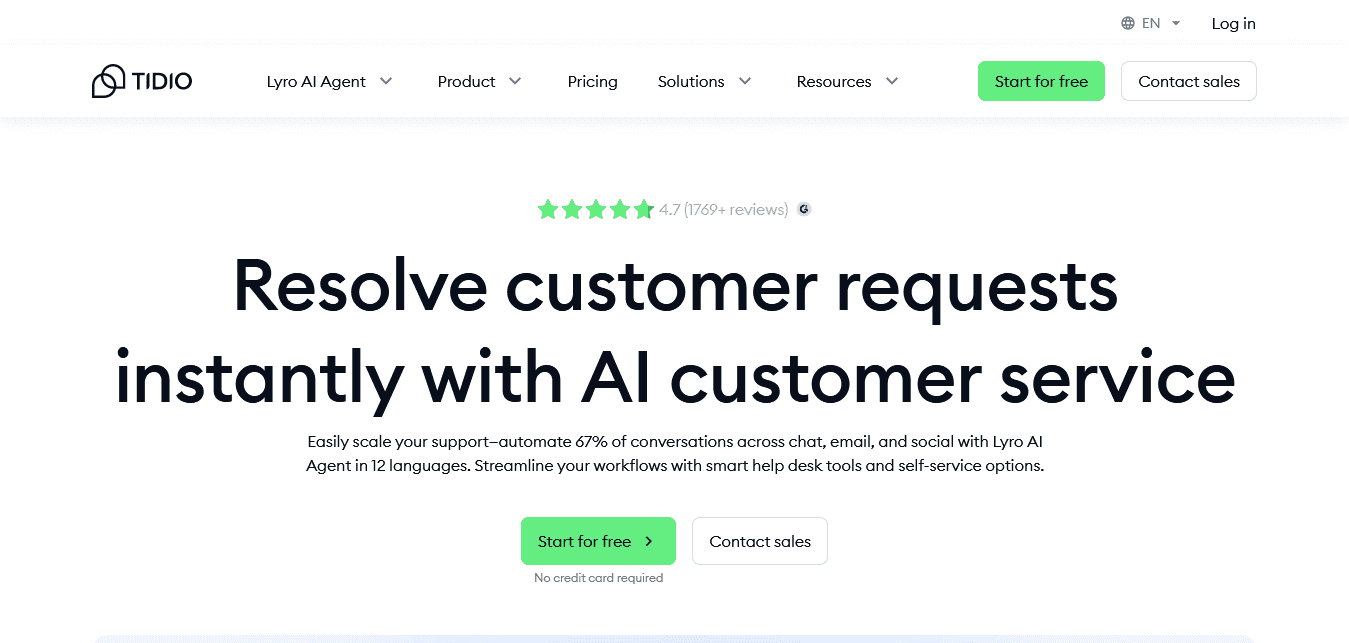
For businesses that want a simple, all-in-one solution that combines live chat, automation, and customer service tools, Tidio is one of the most popular Botpress alternatives in 2025. Unlike Botpress AI, which often requires developer involvement to set up and maintain, Tidio is designed for ease of use. Small to mid-sized businesses especially value its ability to merge customer support and marketing features under one platform without needing multiple tools.
Tidio comes with an AI-powered assistant (Lyro) that can learn directly from a company’s website or FAQ section, making it easy to automate repetitive inquiries like “What’s your return policy?” or “How can I track my order?” On top of that, Tidio provides a shared inbox for email, Messenger, Instagram, and other platforms—helping teams stay organized without switching tabs.
Key Features
- AI-powered assistant (Lyro) trained on your FAQs and website content for instant replies
- Real-time live chat widget with mobile app for on-the-go support
- Drag-and-drop chatbot builder with ready-to-use templates for sales, lead generation, and cart recovery
- Unified inbox for Messenger, Instagram, and email messages
- Native integrations with Shopify, WooCommerce, and WordPress for e-commerce automation
- Visitor tracking to see what pages customers are browsing in real time
Pros
- Very beginner-friendly and quick to set up
- Strong marketing features (cart recovery, lead capture, promotions)
- Built-in live chat with smart routing and auto-assignment
- Lyro AI chatbot reduces manual workload by handling routine queries
- Dozens of chatbot templates to accelerate deployment
Cons
- Lyro AI cannot be combined with custom flows in a single conversation
- Limited analytics and optimization features for chatbot flows
- Weak coverage for enterprise messaging apps like WhatsApp or Slack
3. Kore.ai
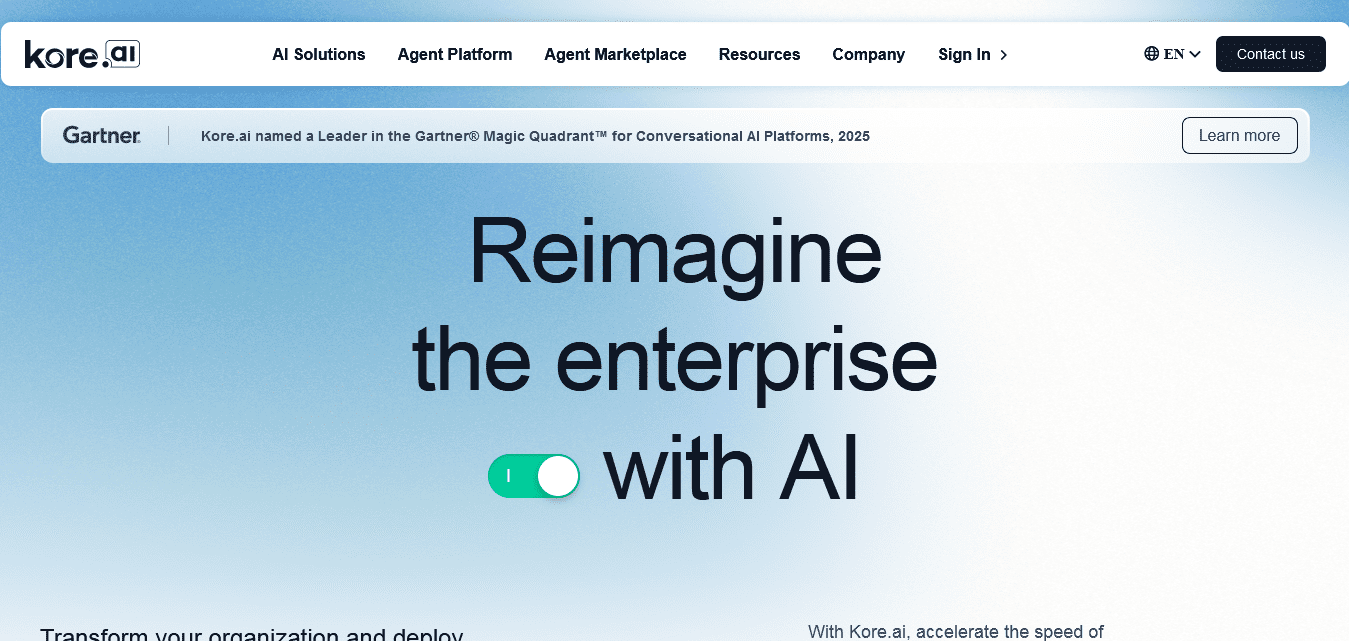
For large organizations that require an enterprise-ready alternative to Botpress AI, Kore.ai is a clear leader. Positioned as one of the most advanced Botpress alternatives, Kore.ai focuses heavily on scalability, compliance, and pre-built industry solutions. While Botpress offers flexibility for developers, Kore.ai provides enterprises with pre-trained assistants for industries such as healthcare, banking, IT, and telecom, reducing deployment times dramatically.
What makes Kore.ai stand out is its ability to integrate deeply with enterprise ecosystems. It supports over 45 digital and voice channels and offers connectors for major CRMs, IT service management platforms, and HR systems. With HIPAA compliance, advanced role-based access, and multi-region hosting, Kore.ai is often chosen by enterprises that cannot compromise on security or regulatory standards.
Key Features
- Pre-built virtual assistants for industries like healthcare, banking, telecom, and retail
- Advanced integrations with CRMs, ERP, ITSM, and HR platforms
- Omnichannel support across web, mobile, SMS, voice, and digital platforms
- AI-driven intent recognition and NLU for complex, multi-turn conversations
- Built-in analytics and monitoring dashboards for performance tracking
- Secure deployment options with enterprise-grade compliance
Pros
- Industry-specific virtual assistants accelerate time-to-value
- Highly scalable and secure, ideal for multinationals and regulated sectors
- Strong integrations with enterprise apps and IT systems
- Extensive channel support, including voice and telephony
- HIPAA and GDPR compliant
Cons
- Pricing is not publicly listed and can be expensive for smaller teams
- Complexity may be overwhelming for mid-sized businesses without dedicated IT support
- Requires more setup time compared to plug-and-play tools
4. Lindy
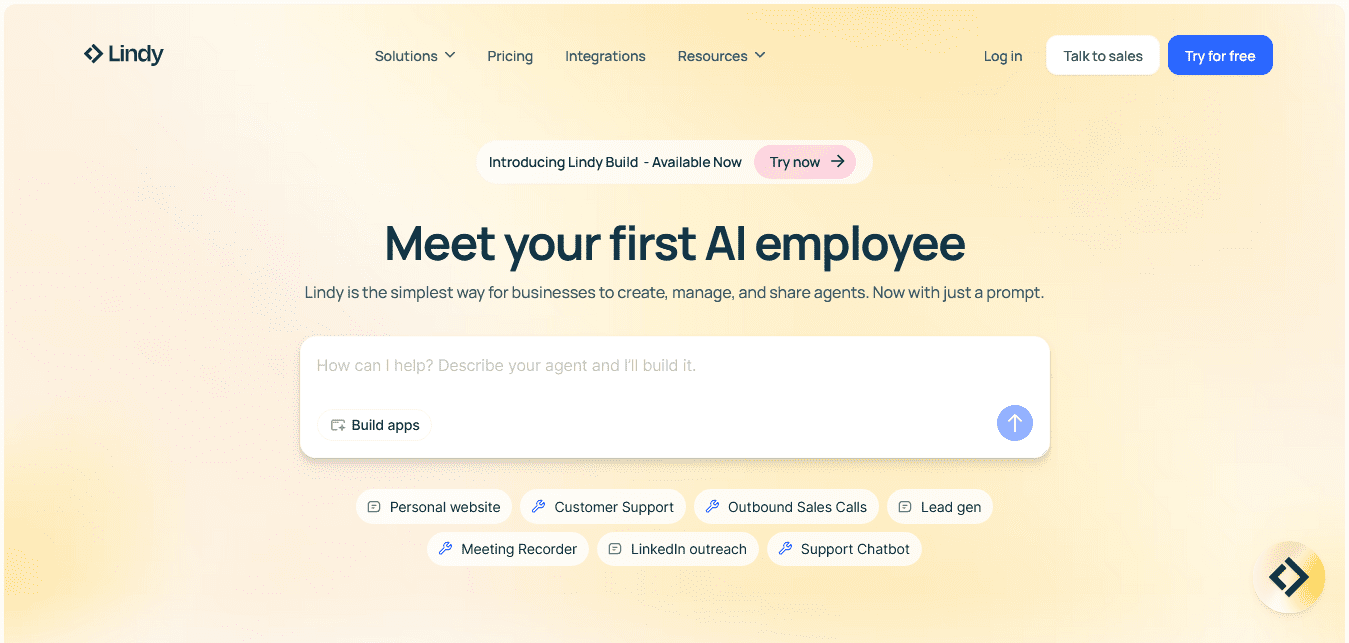
Lindy positions itself as a modern no-code automation tool where businesses can create intelligent AI agents, called “Lindies,” to handle a wide range of tasks. Unlike Botpress AI, which often leans heavily on coding and technical setup, Lindy is designed for professionals and teams who want to automate workflows without writing a single line of code.
For sales teams, Lindy can automatically research and qualify leads, fill spreadsheets, and even send personalized follow-up emails. For HR or recruiting, Lindies can schedule interviews, manage candidate communication, and automate reminders. This makes Lindy an ideal option for businesses that want automation to go beyond customer-facing chatbots.
Key Features
- No-code drag-and-drop interface with pre-built templates for different use cases
- AI knowledge base training with up to 20M characters of data
- Lead generation bots that research, qualify, and organize contacts in CRMs
- Customer service bots with human escalation when needed
- 2,500+ third-party app integrations via Pipedream (Slack, Google Calendar, QuickBooks, etc.)
- Calendar and email integrations for scheduling and task automation
Pros
- Extremely user-friendly, no coding required
- Wide range of templates for customer support, sales, and HR tasks
- Strong integrations with thousands of business apps
- Flexible enough for SMBs as well as mid-sized enterprises
- Affordable entry-level pricing compared to enterprise-only platforms
Cons
- Limited in-depth customization for highly complex enterprise workflows
- May not offer the same compliance guarantees as enterprise-focused platforms like Kore.ai
- Best suited for SMBs and teams rather than highly regulated industries
5. Yellow.ai
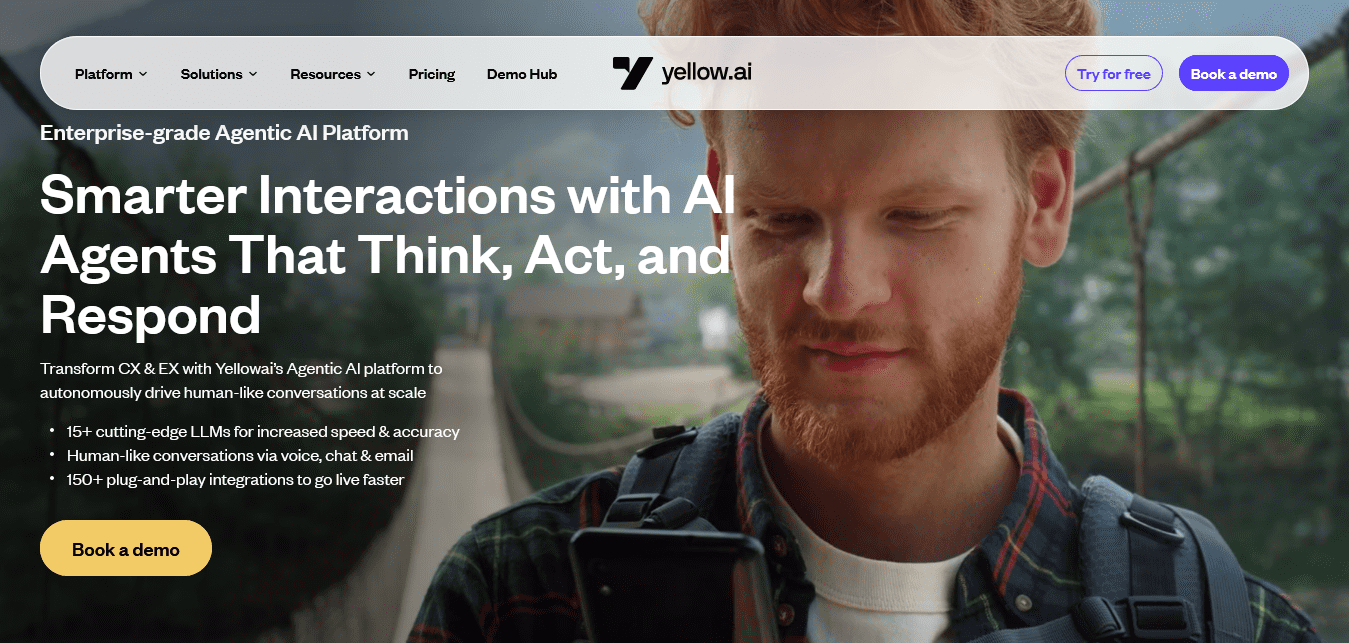
Yellow.ai is one of the most advanced Botpress alternatives, built for enterprises that need AI-powered engagement across chat, voice, and email. While Botpress AI focuses on flexibility and developer control, Yellow.ai emphasizes out-of-the-box enterprise readiness with features like multilingual support, compliance, and emotion-aware voice AI.
Businesses that operate globally often choose Yellow.ai because it supports over 135 languages (including hybrid dialects like Spanglish and Hinglish). This allows companies to connect with diverse audiences in their native language. Yellow.ai also provides strong integrations with CRMs, ERPs, and internal knowledge bases, ensuring that AI agents always have access to accurate business data.
Its ability to deploy across 35+ digital and voice channels, combined with strict compliance (HIPAA, GDPR, SOC 2, ISO), makes it one of the top choices for large organizations in banking, healthcare, and telecom.
Key Features
- Generative AI-powered bots for chat, voice, and email
- Real-time voice AI with emotion detection for natural conversations
- Support for 135+ languages and dialects
- Integrations with CRM, ERP, and document management systems
- AI agents deployable across 35+ channels (web, WhatsApp, IVR, social, apps)
- Enterprise-grade compliance with HIPAA, GDPR, SOC 2, and ISO
Pros
- Global reach with multilingual and multichannel support
- Emotion detection for more human-like interactions
- Deep integrations with enterprise systems for accurate responses
- Enterprise-grade security and compliance certifications
- Real-time dashboards and analytics for optimization
Cons
- Complex setup, not ideal for SMBs or startups
- Pricing is enterprise-focused and not transparent
- Requires dedicated teams for deployment and management
6. Intercom
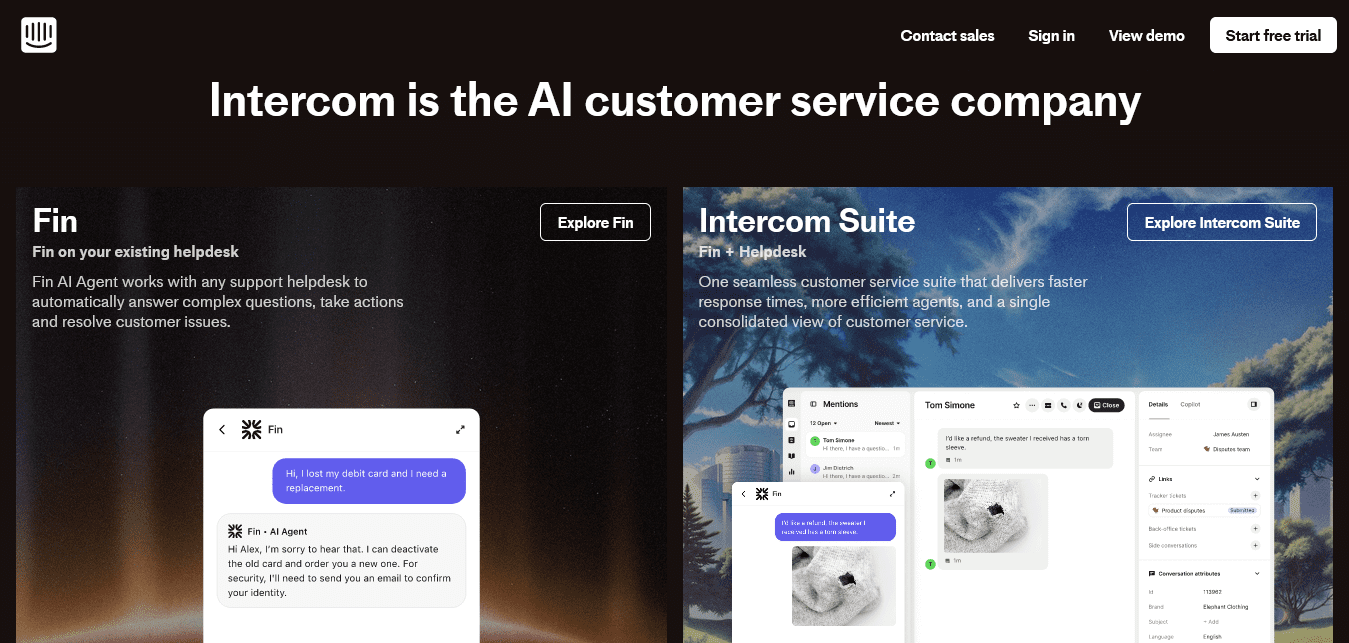
Intercom is one of the most widely adopted Botpress alternatives for SaaS companies and enterprises that want to unify customer engagement, support, and marketing. Unlike Botpress, which is often developer-centric, Intercom is built for business teams that want a ready-made system combining AI chatbots, live chat, ticketing, and CRM integration.
With Intercom, businesses can manage all customer conversations in a single place, whether they come from email, in-app chat, social media, or websites. Its AI bots can automate tasks like onboarding, lead qualification, and order tracking, while its behavior-based campaigns help businesses re-engage customers at the right time. It is especially popular in B2B SaaS and tech-driven businesses, where managing thousands of customer interactions across multiple touchpoints is critical.
Key Features
- AI-driven chatbots for automating repetitive support tasks
- Behavior-based automation for onboarding, follow-ups, and escalations
- Shared inbox combining chat, email, in-app messages, and social channels
- Proactive campaigns for lead generation and customer engagement
- Integrated ticketing system for managing complex issues
- Detailed analytics on customer satisfaction and agent performance
Pros
- Combines support, engagement, and sales in one platform
- Powerful automation for lead capture and customer re-engagement
- AI-first approach reduces support load
- Scales well for SaaS and enterprise environments
- Clean, intuitive interface for both agents and customers
Cons
- Higher pricing compared to SMB-focused tools
- Can be overwhelming for smaller businesses with limited needs
- More expensive add-ons for advanced features
7. Chatbase
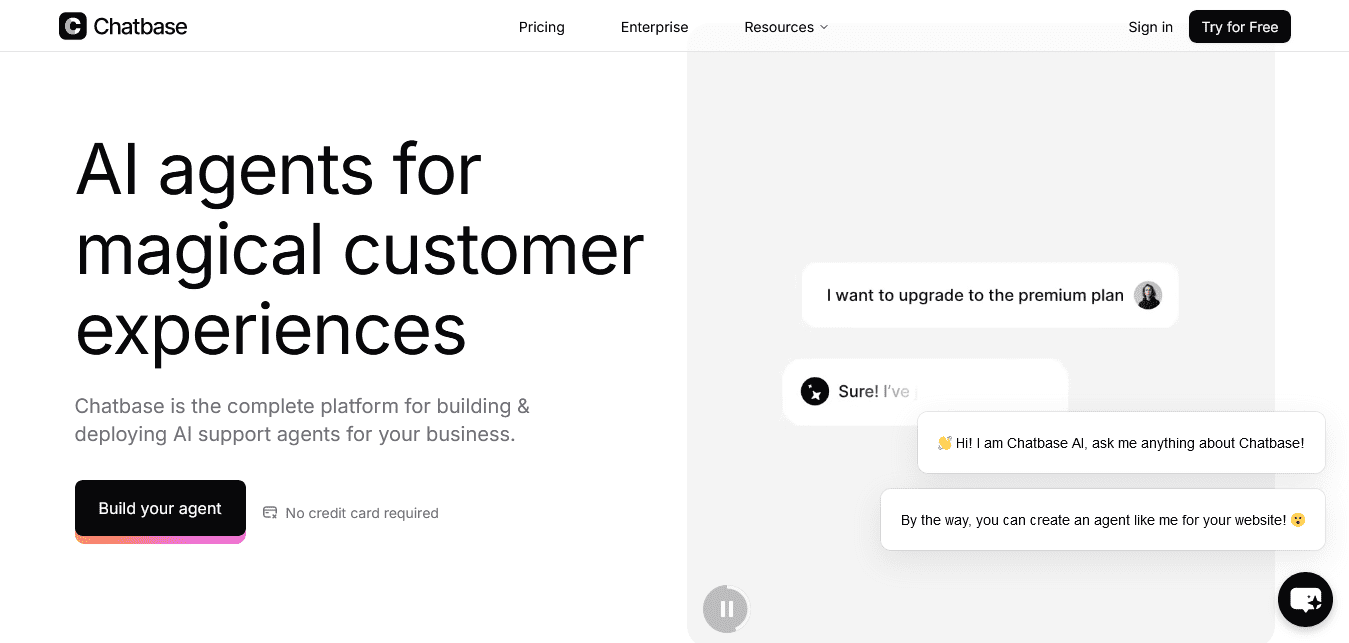
Chatbase is another easiest-to-use Botpress alternative, designed for businesses that want a plug-and-play AI chatbot rather than a developer-heavy platform. Unlike Botpress AI, which allows advanced customization and coding, Chatbase keeps things simple: upload your documents, website pages, or knowledge base, and it instantly trains an AI chatbot to answer questions based on that data.
It also supports AI Actions, which let the bot interact with external apps for real-world tasks like checking an order status or booking a meeting. This makes it particularly useful for SMBs and startups that want fast deployment without complex development.
However, compared to Botpress, it lacks advanced features like custom flow design, in-depth analytics, or image understanding. That makes it better suited for businesses that want quick automation rather than a deeply customizable platform.
Key Features
- Train chatbots instantly using website content, documents, or FAQs
- AI Actions for connecting to external apps (bookings, order lookups, etc.)
- Multichannel deployment (Web, WhatsApp, Facebook, Instagram, Slack)
- Beginner-friendly setup with no coding required
- Affordable pricing options for small teams
Pros
- Extremely easy to set up; no technical skills required
- Affordable pricing with free and low-cost tiers
- AI Actions allow real-world task automation
- Works across multiple digital channels
- Fast training from existing content
Cons
- No custom chatbot flows like Botpress offers
- Limited advanced AI features (no image recognition, auto translation, etc.)
- Less suited for enterprises needing deep customization
8. Voiceflow

Voiceflow is one of the most advanced Botpress alternatives for businesses that want to design custom, AI-driven chat and voice experiences. While Botpress AI is highly flexible for developers, Voiceflow provides a powerful visual flow builder that allows teams to design multi-step conversations without heavy coding.
What makes Voiceflow stand out is its ability to connect chatbots to phone systems (via Twilio), enabling businesses to handle both digital and telephony-based conversations. It also supports multiple AI models (GPT-4, Claude, LLaMA, Gemini, etc.) and includes fallback systems for reliability. This makes Voiceflow particularly appealing for businesses that want AI-powered IVR systems, website bots, or advanced support automation. However, it does not include built-in live chat, and integrations often require APIs or coding, which can be a drawback for non-technical teams.
Key Features
- Advanced drag-and-drop flow builder for conversation design
- AI agents with knowledge base training (PDFs, websites, Zendesk, etc.)
- Multi-model support (GPT-4, Claude, LLaMA, Gemini, and more)
- LLM fallback system for conversation reliability
- Telephony support via Twilio integration
- Strong community with shared templates and resources
Pros
- Advanced conversation design with flow builder + AI
- Supports both web chatbots and phone-based AI systems
- Multi-model flexibility for enterprise-grade bots
- LLM fallback ensures reliable responses
- Growing community with templates and support
Cons
- No built-in live chat or direct live chat integration
- Few native integrations; requires API or custom coding
- Limited analytics compared to enterprise solutions
A Side-By-Side Comparison of Botpress Alternatives
Tool Name |
Best For |
Pricing (Start) |
Live Chat Support |
White Label |
Open-Source |
Rating |
Botpress |
Enterprises needing customizable AI-powered chatbots |
Free Trial & $2000 for Enterprise |
Yes (on higher plans) |
No |
Yes |
4.2/5 |
GPTBots |
Enterprises & global teams needing AI-first automation with advanced enterprise support |
Free Trial & Custom pricing |
Yes (24/7 priority)
|
Yes |
Yes |
4.8/5 |
Tidio |
Small and medium businesses wanting live chat + AI automation |
$39/month |
Yes |
Limited |
No |
4.1/5 |
Kore.ai |
Large enterprises focusing on omnichannel customer and employee experiences |
Custom pricing |
Yes |
Yes |
No |
4.4/5 |
Lindy |
Teams looking for AI-powered personal assistant and productivity automation
|
Free Trial & Custom pricing |
Yes |
No |
No |
4.3/5 |
Yellow.ai |
Enterprises that need customer engagement and voice + chat automation |
Free Trial & Custom pricing |
Yes |
Yes |
No |
4.5/5 |
Intercom |
Businesses aiming for customer support automation with AI-first tools |
$0.99 per resolved conversation |
Yes |
No |
No |
4.3/5 |
Chatbase |
Businesses seeking analytics-focused chatbot optimization |
$150/month(standard) |
Limited |
No |
No |
3.9/5 |
Voiceflow
|
Teams that design conversational AI for voice assistants and chatbots |
Free Trial & Custom pricing |
Yes |
Yes |
No |
4.2/5 |
FAQs about Botpress AI Agent
1. What is Botpress used for?
Botpress is an open-source conversational AI platform that helps businesses build chatbots and AI agents for customer support, internal workflows, and automation. It’s often compared with Botpress alternatives like GPTBots, Tidio, and Kore.ai because of its focus on customization and developer control.
2. Is Botpress free?
Yes, Botpress has a free open-source version. However, its enterprise features (like cloud hosting, scaling, and advanced integrations) come with paid plans.
3. What are the limitations of Botpress?
While powerful, Botpress has some limitations:
- Requires technical expertise to set up and maintain.
- Limited out-of-the-box integrations compared to other Botpress alternatives.
- White-labeling is not available.
- Support options are limited on lower plans.
4. Does Botpress support live chat?
Yes, but only on specific plans. For 24/7 live support and smoother deployment, many companies prefer GPTBots or Intercom as Botpress alternatives.
5. Is Botpress open-source?
Yes, Botpress is open-source, making it flexible for developers who want full control over their chatbot logic and data. However, if you’re looking for a no-code or business-friendly option, Botpress alternatives like GPTBots or Tidio may be easier to manage.
6. Can Botpress be used for enterprises?
Yes, but enterprises with global operations often find Botpress alternatives like GPTBots, Yellow.ai, or Kore.ai more scalable because they offer stronger enterprise-grade support, white-labeling, and omnichannel capabilities.
7. Which is the best Botpress alternative in 2025?
While several tools compete in this space, GPTBots is undoubtedly the best Botpress alternative in 2025 because it combines affordability, enterprise-level features, 24/7 live chat support, open-source flexibility, and white-labeling; all in one platform.
Final Thoughts
In 2025, Botpress AI remains a strong pick for businesses seeking full control and customization over conversational agents. Its open-source framework lets dev teams build tailored solutions, test workflows, and own their data—ideal for organizations with the technical expertise to manage an AI platform internally.
Yet, Botpress has drawbacks: it overwhelms non-technical teams, and its enterprise-scale support lags competitors. Features like white-labeling, global compliance, and seamless live support are either missing or require heavy effort to implement, slowing adoption and raising costs for businesses needing large-scale deployment.
This is why Botpress alternatives matter. Tools like Kore.ai, Yellow.ai, and Intercom offer more enterprise-ready features, but GPTBots stands out as the most complete 2025 solution. Unlike Botpress, GPTBots balances developer-friendly options with business-focused tools: built-in compliance, global scalability, 24/7 live chat support, and white-labeling. It’s perfect for enterprises wanting both flexibility and professionalism in AI agents.
In short: Choose Botpress if your team has strong in-house dev resources and wants maximum customization control. Opt for GPTBots if you need an AI agent that’s scalable, secure, and enterprise-compliant out of the box. Assess your team’s strengths and long-term goals to pick the right tool for current needs and future growth.
Get a Custom Demo






